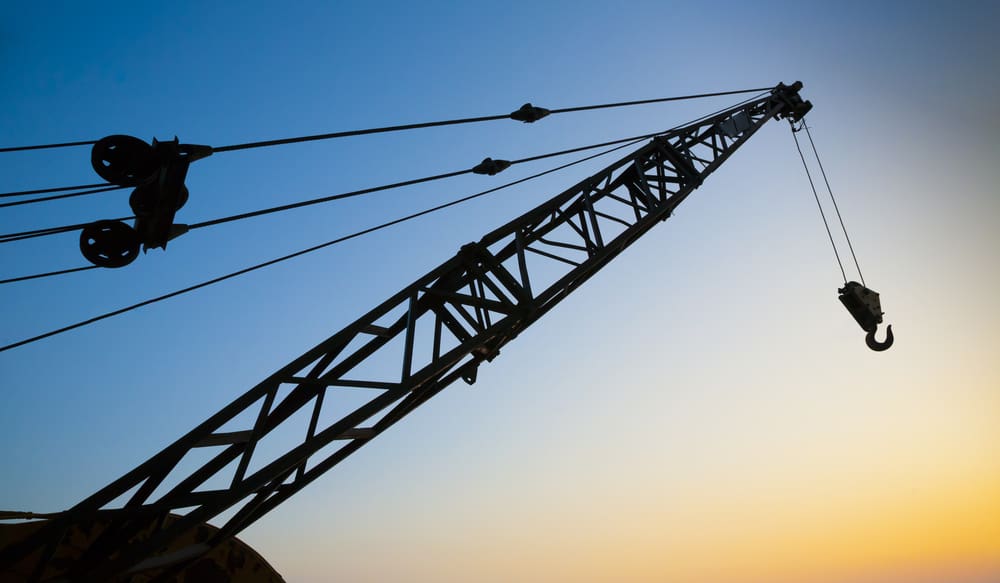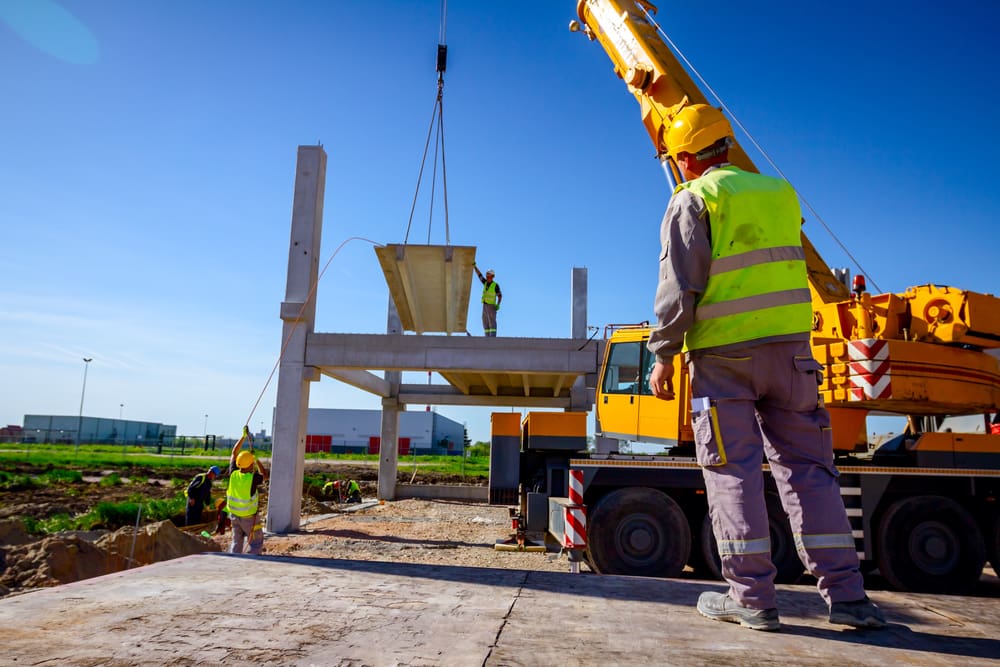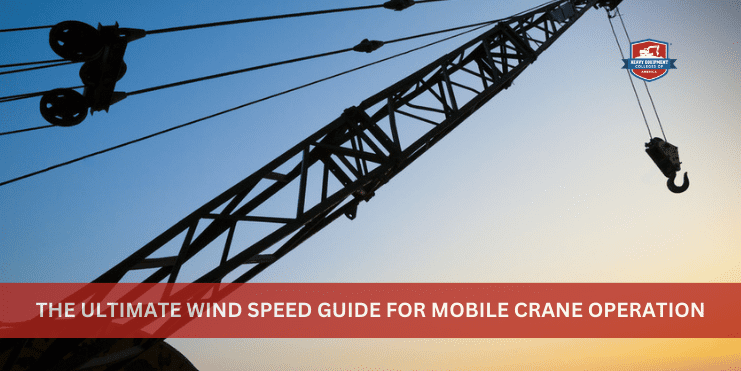Wind speed plays a major role in crane safety. According to the American National Standards Institute, 1,125 crane accidents were reported worldwide over ten years with 23% of them being caused by wind exposure. High wind speed reduces the stability of mobile cranes, making them more susceptible to damage and putting workers at risk.
Keep reading to learn more about how wind speed impacts crane operation, how to handle high winds, and when to stop operations for safety reasons.
Table of Contents
Understanding the Effects of High Wind on Mobile Cranes
Knowing how high winds affect mobile cranes is essential for safe and effective operations. Let’s take a look at what factors play a role.

Wind Forces
- Aerodynamic pressure: When wind hits the crane’s surface, it creates aerodynamic pressure. This pressure fluctuates based on the wind’s speed and how much of the crane it affects.
- Lift and drag: The wind creates lift, which causes the crane to tilt or lift from its base, and drag, which can cause the crane to move horizontally.
- Twisting effects: Wind can also cause the crane to twist on its base to a point where it becomes unstable.
Factors That Influence Wind Impact
- Height: Since wind pressure is stronger at high altitudes, taller cranes encounter more of it.
- Wind speed: Higher wind speeds create more aerodynamic pressure. The greater the aerodynamic pressure, the less stable and secure the crane becomes.
- Load: The type of load the crane is lifting, including its weight and position, determines how wind impacts the equipment.
- Boom length: A boom is the arm that juts out on a crane. A longer boom has greater leverage, which reduces the impact of wind forces on the crane.
The Importance of Predicting and Preparing for Wind Loads
- Stability and safety: Accurately predicting wind loads helps crane operators determine how stable the equipment will be under varying windy conditions. These predictions help reduce the risk of accidents on the job.
- Operational efficiency: When operators know what wind speed to expect during a lift, they can plan it more efficiently to reduce downtime and increase productivity—without sacrificing safety.
- Structural integrity: Constant exposure to high winds accelerates equipment wear and tear, which can reduce the crane’s structural integrity. Predicting and preparing for wind loads protects the crane from premature wear and tear and maximizes its lifespan.
What Is a Safe Wind Speed for Mobile Crane Operations?
While different cranes have different wind speed thresholds, some wind speeds are generally safe or a cause for concern. Wind speed is categorized into these five groups:
- Very calm: wind speeds below 4.47 mph
- Calm: wind speeds between 4.48 mph and 11.16 mph
- Low: wind speeds between 11.17 mph and 22.35 mph
- Medium: wind speeds between 22.36 mph and 33.53 mph
- High: wind speeds over 34 mph

How Can Wind Speed Impact Mobile Crane Capacity?
The lift capacity of a crane decreases as wind speed increases because wind speed reduces the equipment’s stability. Here’s how wind speed affects a crane’s load capacity:
- Lateral load on the crane: The lateral force of wind on the crane causes it to shift horizontally. The greater the wind speed, the greater the shift. The crane tries to withstand this force, but doing so puts stress on the crane and causes it to twist or lift, threatening its structural integrity. The crane experiences a lower lift capacity because it must allocate some to offset the lateral force.
- Additional load on the load: Wind speed affects the crane itself and the load it carries, causing it to swing or sway. The crane’s ability to manage this movement while lifting decreases as wind speed increases.
- Tipping and overturning: If wind speed is high enough, it can cause the crane and its load to tip over. This is why predicting and preparing for wind loads is crucial to safe operation. Operators can reduce the load based on the wind speed to prevent tipping.
- Stability and sway: In some cases, wind speed is so high that operators might need to slow the crane’s movements or temporarily pause operations to maintain the crane’s stability.
- Structural stress: Every part of the crane—including the boom, jib, and counterweights—experiences increased stress in high wind conditions. The more stress these components undergo, the quicker they deteriorate, which reduces their load capacity.
How to Handle High Winds?
Wind speeds below 22 mph are generally not a cause for concern. Anything above 22 mph, however, requires a reassessment of the crane’s movements and even the operation itself. If the wind speed is considered medium or high, you should consider making the following adjustments:
- Decrease the angle of the lift
- Decrease the weight of the load
- Reduce the height of the lift
You should have a plan in place for operating a crane in windy conditions. That way you’ll be prepared when the time comes and not be left scrambling at the last minute. And remember, a shorter timeline is never worth damaging equipment or putting workers at risk. If you need to pause or postpone operations, don’t hesitate to do so.
Careers in the Construction Trade
When You Should Stop a Crane Due to Strong Wind Speed?
As we mentioned above, some conditions call for the suspension of crane operations. Factors such as the type of crane, wind speed, and wind gusts help operators determine whether to continue or postpone a lift. A general rule of thumb is to stop operations when wind speed exceeds 22 mph. Here are some additional factors to consider.
1. Manufacturer’s Specifications
Every crane comes with wind speed ratings and operational guidelines from the manufacturer. This information details the highest wind speed a crane can safely withstand. If wind speed exceeds the limit outlined, don’t operate the crane. Failing to do so would reduce the crane’s stability, putting its structural integrity at risk.
2. Local Regulations
In addition to manufacturers, local regulations or industry standards might set a maximum wind speed capacity for crane operation to protect cranes from damage and workers from getting injured on the job. If conditions aren’t conducive to equipment and worker safety, press pause on operations.
3. Crane Type
Different crane types have varying wind speed capacities. Typically, taller cranes have lower wind speed capacities while cranes with a longer boom have higher wind speed capacities. If wind speed is too high to safely operate the particular crane you’re using, wait until conditions improve to resume operations.
4. Wind Speed and Wind Gusts
Don’t operate a crane when wind speed exceeds 22 mph and/or wind gusts are present.
5. Local Wind Patterns
Some regions experience higher wind speeds and more wind gusts than others, such as coastal areas. Take local wind patterns into account when planning a lift. If necessary, wait to begin or continue operations until wind conditions stabilize.
6. Crane Configurations
Factors such as the weight of the load and the length of the boom impact crane performance in windy conditions. Heavier loads and longer booms give the crane more leverage, making it less susceptible to movement. If your load is light or the crane’s boom is shorter, you should pause operations until wind speed decreases.
7. Operator Judgment
If the crane starts to sway, is difficult to control, or feels unstable, stop operations immediately to prevent tipping and other hazards.
Find a Mobile Crane Operator Training Program Near You
Heavy Equipment Colleges of America equips students for careers as crane operators by combining expert classroom instruction with practical hands-on experience. Our accelerated crane programs can be completed in as little as three weeks so you don’t have to put your life on hold to get the training you need.
Ready to take the first step? Apply to a heavy equipment program at our California, Georgia, or Oklahoma location. The team at HEC will help you get where you want to go.
Start Your Crane Operator Career With Confidence
Kickstart Your Crane Operator Journey Today!
Hands-On Training | OSHA-Compliant Courses | Job-Ready Skills
Become a Certified Tower Crane Operator Today!
Start Enrollment ProcessFind The Right Location For You
